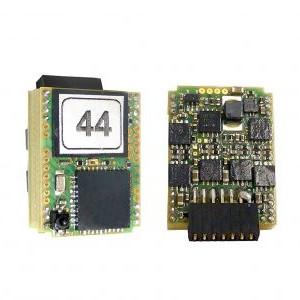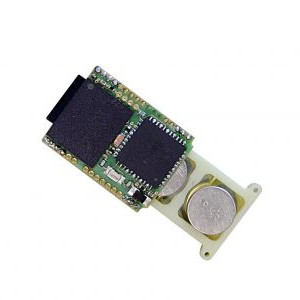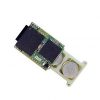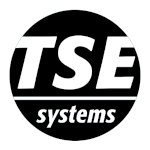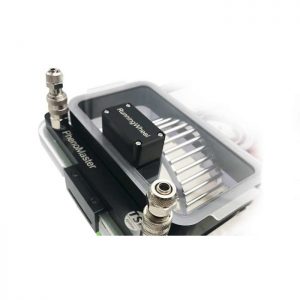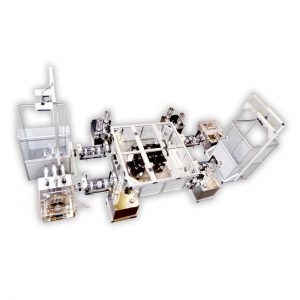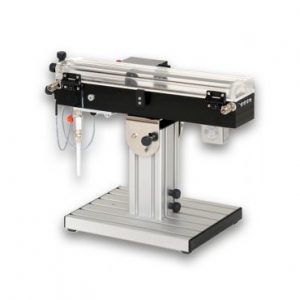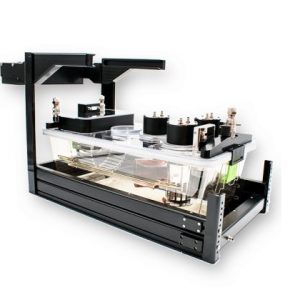Product Enquiry
If you would like to send us an enquiry about this product, please click the button below, fill in the form and submit.
Product EnquiryNeurologger
EEG Data Logger
NeuroLogger is a unique and elegant solution for wireless recording of EEG activity in animals as small as mice. The NeuroLogger can be used in freely moving animals performing a variety of behavioral paradigms as well as in the field of animal models for epilepsy and sleep disorders.
The NeuroLogger is a plug on/off data logger allowing 4 channel EEG/EMG recording and is characterized by a straightforward and inexpensive way to change batteries between recording cycles. An external event recorder securities data synchronization with external parameters such as video-tracking and others.
The NeuroLogger can be used in combination with behavioral and metabolic analysis systems such as the Multi Conditioning System or the PhenoMaster.
Features
- Wireless data logger
- EEG/EMG recording in freely moving animals
- Recording during behavioral testing
- Infrared communication with external event recorder
- Movement sensor
- Up to 90 hours uninterrupted recording
Applications
- EEG/EMG
- Sleep stage analysis
Disease Models
- Alzheimer´s
- Epilepsy
- Huntington’s
- Migraine
- Schizophrenia
- Sleep
Selected Publications
Raith H, Schuelert N, Duveau V, Roucard C, Plano A, Dorner-Ciossek C, Ferger B. Differential effects of traxoprodil and S-ketamine on quantitative EEG and auditory event-related potentials as translational biomarkers in preclinical trials in rats and mice. Neuropharmacology 2020; 171: 108072
Schuelert N, Dorner-Ciossek C, Brendel M, Rosenbrock H. A comprehensive analysis of auditory event-related potentials and network oscillations in an NMDA receptor antagonist mouse model using a novel wireless recording technology. Physiol Rep 2018; 6(16): e13782
Bielefeld P, Sierra A, Encinas JM, Maletic-Savatic M, Anderson A, Fitzsimons CP. A standardized protocol for stereotaxic intrahippocampal administration of kainic acid combined with electroencephalographic seizure monitoring in mice. Front Neurosci 2017; 11: 160
Corcoran KA, Frick BJ, Radulovic J, Kay LM. Analysis of coherent activity between retrosplenial cortex, hippocampus, thalamus, and anterior cingulate cortex during retrieval of recent and remote context fear memory. Neurobiol Learn Mem 2016; 127: 93-101
Lampert T, Plano A, Austin J, Platt B. On the identification of sleep stages in mouse electroencephalography time-series. J Neurosci Methods 2015; 246: 52-64.
Selected Product Citations
Activation of group II metabotropic receptors attenuates cortical E-I imbalance in a 15q13.3 microdeletion mouse model |
|
| Funk Marzieh, Schuelert Niklas, Rosenbrock Holger | bioRxiv | Published 17 Sep 2020 |
| Article Snippet PrePrint: Then, 5 gold-plated steel screws each with a connector cable and a metal pin were implanted into the cranium superficially of the dura mater.. A socket with the connector pins to attach the Neurologger (TSE systems) was implanted and fixed with dental cement.. At the end of the surgery, animals received an injection of meloxicam, metacam 0.01 mg/kg i.p., and baitril s.c. over 5 days. |
|
The sleep-wake distribution contributes to the peripheral rhythms in PERIOD-2 |
|
| Hoekstra Marieke M.B., Jan Maxime, Franken Paul | bioRxiv | Published 26 Jul 2020 |
| Article Snippet PrePrint: 8-10 days post-surgery, mice were placed in the RT-Biolumicorder at the end of the light phase (∼ZT10-ZT12) for two days in LD to habituate to the novel environment.. At the end of the second habituation day, the dummy was replaced with a wireless EEG (Neurologger, TSE Systems GmbH).. After two-and-a-half days of baseline recording in constant darkness, mice were sleep deprived for six hours at a time they were expected to rest (ZT0 under LD conditions) by gentle handling as described ( ). |
|
Differential effects of traxoprodil and S-ketamine on quantitative EEG and auditory event-related potentials as translational biomarkers in preclinical trials in rats and mice. |
|
| Henrike Raith, Niklas Schuelert, …, Boris Ferger | Neuropharmacology | Published 31 Mar 2020 |
| Article Snippet Abstract: Quantitative Electroencephalography (qEEG) and event-related potential (ERP) assessment have emerged as powerful tools to unravel translational biomarkers in preclinical and clinical psychiatric drug discovery trials.. The aim of the present study was to compare the GluN2B negative allosteric modulator (NAM) traxoprodil (CP-101,606) with the unselective NMDA receptor channel blocker S-ketamine to give insight into central target engagement and differentiation on multiple EEG readouts. |
|

